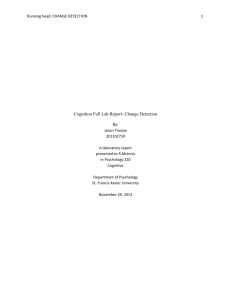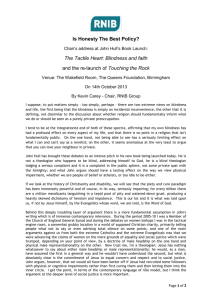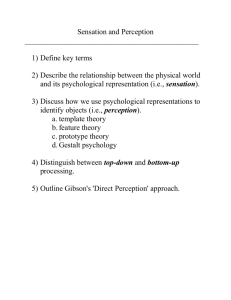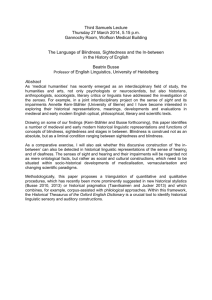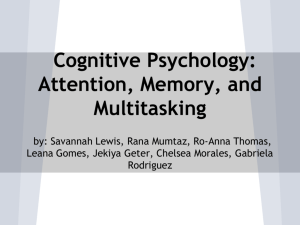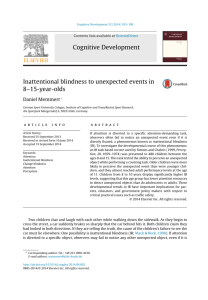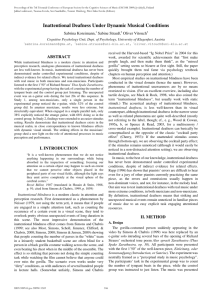Perception depends on attention
advertisement
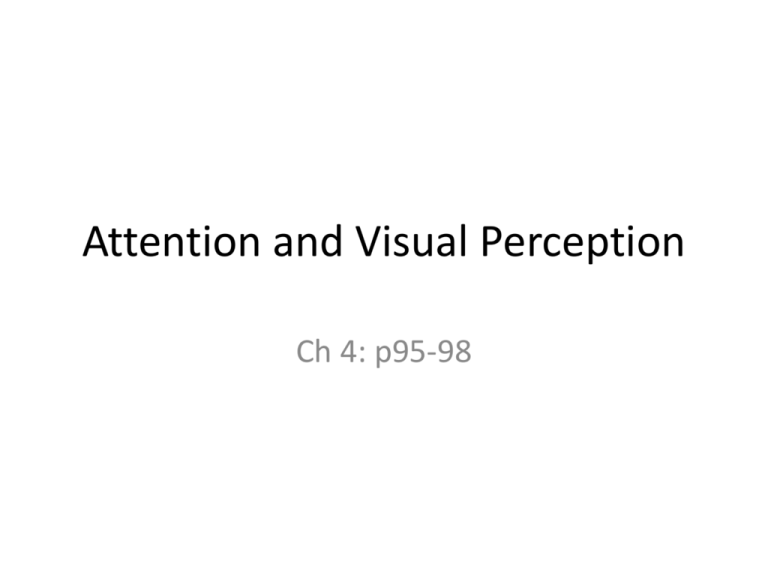
Attention and Visual Perception Ch 4: p95-98 What is attention?? • Attention is a mental process – Effortful • Attention requires mental resources – Limited • Attention can be involuntary or voluntary – Stimulus-driven or automatic (like a reflex) – Goal-driven or controlled (like a filter or zoom lens) Research question: • Do we capture MORE or LESS information than we realize? Instructions • You will see 2 teams of players – one wearing white t-shirts and one wearing black t-shirts. Try to count the total number of times the team wearing white passes the ball. Simons & Chabris (1999) • Question – Does perception depend on attention? • Method – 75s film with surprising event – Ss asked if noticed anything unusual • Results – 46% fail to report event – Selectively attending to white not to black objects • Conclusion – “Inattentional blindness” – Conscious perception depends on attention We can be blind to highly salient events! Simons & Chabris (1999) “Gorillas in our midst: Sustained inattentional blindness for dynamic events” Easy Task Hard Task White Black White Black Transparent Umbrella 58% 92% 33% 42% Gorilla 67% 8% 25% Umbrella 100% 58% 83% 58% Gorilla 50% 58% 8% Opaque 42% 83% • • • • Results: % notice unexpected event Easy: count passes Hard: count air vs bounce passes Color: team attended to Simons & Levin (1998) • Method Exp 1: – 15 pedestrians (20-65yrs) were approached by a person asking directions. After 15s, a door passed between them, and a new person is there afterwards. The entire interaction takes approx 2 – 5min. Two people wore different clothes, and had different voices. • Method Exp 2: • Results: – Expmtr’s dressed as – Only 7 of 15 noticed change – 47%! construction workers • Ss that noticed were same age – Ss all young as expmtrs (20-30yrs) – Only 4 of 12 noticed change – 33% • Conclusion: Inattentional blindness Simons & Levin (1998) • Comments regarding methodology… • External validity: not a real world event – Assumption of unchanging visual world – Ss are not searching for a change • Cause of effect: – Attention focused on task – Similarity of information • Conclusions – We do not have a detailed visual representation of the world Flicker task • This task tests how well you can detect changes when you are trying your best to find them. A photo of a scene will appear briefly and then it will be replaced by a blank screen. After a fraction of a second a changed version of the scene will appear. The original and changed images will alternate for about 10s. Try to find the change. CogLab: Change detection Flicker task • 2009 Data summary: • N=8 • Averages across participants • Flicker – Acc= 61.25% – RT= 10,086ms • No Flicker – Acc = 92.50% – RT= 6,109ms Rensink (2002) • Question – Is attention necessary to detect a change? • Method – Flicker Task – IV: time of blank field between original and modified image – IV: location of change in picture • Results – Took time before change was detected – Impossible to attend to all aspects of a scene at 1 time – Center change detected faster than peripheral change – Requires fixation on 1-4 pieces at a time • Conclusions – Change blindness: Failure to automatically notice change – Requires focused attention (objects or locations) Rensink, O’Regan & Clark (2000) • Standard task: images 240ms w/ 80ms blank • Flicker task variations: • All expmts: central interest vs marginal interest to picture • Exp1: extended preview of Pic1 before flicker • Exp2: IV blank field duration • Exp3: IV blank field colors (black, white, red) • Exp4: “splats” that do not cover change rather than full blank field Type of change 8s “Standard” Red blank field Rensink, O’Regan & Clark (2000) • Change blindness with flicker paradigm findings: • CB occurs when attention is diverted • Central meaning to picture or distinct object is found faster • Attention is necessary to detect change • Attention is not SUFFICIENT to detect change • Need to compare 2 pictures simultaneously • Conclusion: Visual representations are incomplete Levin & Simon (1997) • Method: – Ss watch video with various types of changes • Results: – 1 out of 10 noticed any changes – After told to watch for changes noticed only 25% • Conclusions: – Change blindness – Importance of attention for perception – “Change blindness blindness”: Lack of awareness for ability to notice changes Simons (2000) Current approaches to Change Blindness 5 Causes of Change Blindness Change Blindness and Inattentional Blindness • Attention: necessary but not sufficient to detect change – We don’t store details & we need to attend to objects • Are we just not efficient and accurate processors of (visual) information? – If you tracked every detail, your system would be overwhelmed – Instead visual system gets gist and you ignore the details • What future studies could be conducted? • What are the applications of this research? Links • • • • D. Simons webpage http://viscog.beckman.uiuc.edu/djs_lab/ D. Levin webpage http://www.vanderbilt.edu/psychhumdev/levin/labp age/VisualCognitionLab.html • Demos • http://viscog.beckman.uiuc.edu/djs_lab/demos.html Tse (2004) • Use change blindness paradigm to study how attention is distributed – Assumption: accuracy = attention to that location • Method – – – – – Show frame with green and red squares Show cue (top, down, right, left or none) Blank field Show new frame with one added square Participant asked if new element is green or red • Results – Map probability of accuracies – Cue changed distribution (shape) of focal attention • Conclusion – Attention “hot spots” with gradation Tse (2004) • N=4 • 100hrs training over 4mo • Task: maintain fixation and report whether new element was red or green • IV: cue/no cue • IV: time between cue and new square Tse (2004) • White/ yellow spot • Near perfect % • Changes depending on position of cue – even though irrelevant

